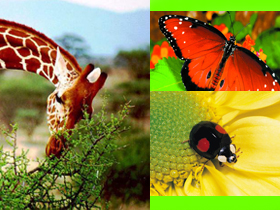Biologists divide living things into specific classes. This classification, known as taxonomy, dates back to Carolus Linnaeus in the 18th century. The classification system that Linnaeus constructed has been expanded and revised, but is still in use today.
This system of classification contains hierarchical categories. Living things are first divided into kingdoms, such as the animal and plant kingdoms. Kingdoms are then subdivided into phyla, which are then further subdivided. Classification takes the following form, in descending order:
kingdom
phylum (plural phyla)
class
order
family
genus (plural genera)
species
Most biologists today accept the existence of five separate kingdoms. In addition to the plant and animal kingdoms, they regard fungi, monera (single-celled organisms with no cell nucleus, such as bacteria) and protista (cells with a nucleus, such as algae) as separate kingdoms.
The most important of these is without doubt that animal kingdom. The major divisions within the animal kingdom are its various phyla. In the classification of these phyla, their differing bodily structures are considered. Arthropods, for example, constitute a separate phylum, and all the creatures within that phylum have a similar body plan. The phylum known as Chordata consists of creatures with a central nervous system. All the animals familiar to us such as fish, birds, reptiles and mammals are included in the vertebrate category, a subdivision of the Chordata.


